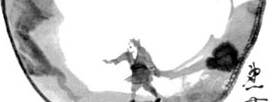OK, so far I have covered the first line of the Heart Sutra. Yay me! Depending on how you count, we are now either going to start on the first or the second line of the Heart Sutra. If we count the title as the first line (which is what I’ve been doing), then here […]
Category: chinese
Searching for the Ox (尋 牛)
忙 忙 撥 草 去 追 尋
busy busy pulling grass go chase search
水 闊 山 遙 路 更 深
water wide mountain distant path deeper
Writing the Ox, the short version (just the titles)
十牛圖
十 (shí: ten) / 牛 (niú: ox) / 圖 (tú: picture/diagram)
尋牛序一
尋 (xún: to search) / 序 (xù: number) / 一 (yī: one)
The Six Distortions (from the Analects)
From the Analects, 17.6: 好仁不好學、其蔽也愚。 好知不好學、其蔽也蕩。 好信不好學、其蔽也賊。 好直不好學、其蔽也絞。 好勇不好學、其蔽也亂。 好剛不好學、其蔽也狂。 Confucius once asked Zhòng Yóu (仲由) if he had heard of “the six words and the six distortions”. Yóu said he had not. The Master then explained as follows: The “six words” (六言) are: 仁 (kindness), 知 (wisdom), 信 (reliability), 直 (honesty), 勇 (courage), and […]
心經: How to write “Heart Sutra” in Chinese characters
The last two characters in the first line of the Heart Sutra are 心經: 摩 訶 般 若 波 羅 蜜 多 心 經ma ha ban ya ba ra mil ta shim gyong The first of these characters is 心 (xīn), is the Chinese character for “mind” and also for “heart”. The character 心 is actually used to translate two different Sanskrit words in […]
The Heart Sutra text
1—————————————————————————————– 摩 訶 般 若 波 羅 蜜 多 心 經 ma ha ban ya ba ra mil ta shim gyong great prajna para mita heart sutra2—————————————————————————————– 觀 自 在 菩 薩 行 深 般 若 kwan ja jae bo sal […]
波羅蜜多, Part Two (how to write पारमिता/pāramitā in Chinese characters)
蜜多 is the second part (the third and fourth characters) of 波羅蜜多, which is the Chinese transliteration of पारमिता/pāramitā. 蜜 (pinyin: mì) is the Chinese word for “honey”. It can also be used to refer to the color of honey, or to anything that is sweet. It is made up of three characters stacked one […]
波羅蜜多, Part One (how to write पारमिता/pāramitā in Chinese characters)
So far I’ve done the first four characters in the first line (the title) of the Heart Sutra in Chinese. The next four characters comprise the Chinese transliteration of the Sanskrit पारमिता (pāramitā), which is 波羅蜜多. Just to make sure we are all on the same page, here is the first line of the Heart […]
般若: How to write प्रज्ञा (prajñā) in Chinese characters
The first two characters in the Heart Sutra are 摩訶, which is the Chinese transliteration of महा (mahā́), which in English means “great”. The third and fourth characters are 般若, which is the Chinese transliteration of प्रज्ञा (prajñā), which in English means, more or less, “wisdom”. But actually it’s best not to assume that prajñā […]
The amazing adventures of Zen Master Moheyan in Tibet, Part One
Once upon a time Zen was very popular in Tibet. That is to say, it was popular in the way that Country Music is popular. Some people really liked it, but others weren’t so sure. The early history of Zen in Tibet is actually a lot like the early history of Zen in China. In […]






